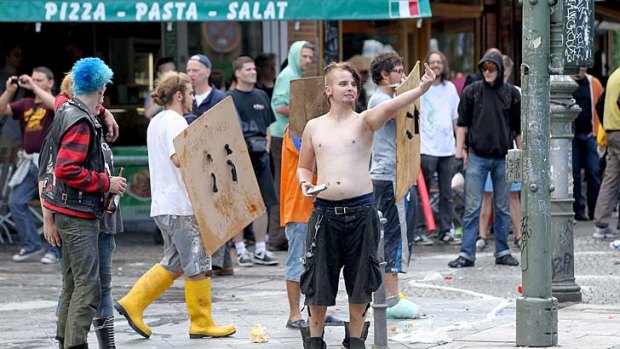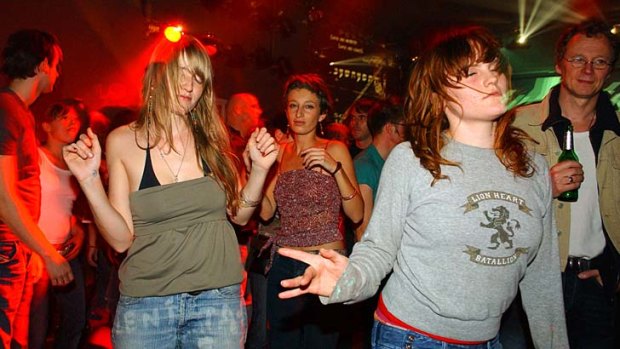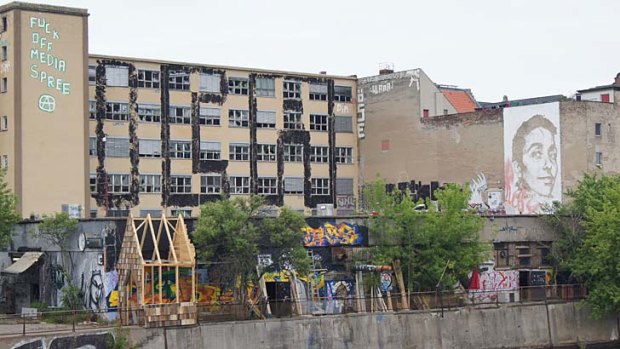This was published 10 years ago
Battle for the soul of Europe's 'poor but sexy' city
By Craig Platt
Our tour guide Johnny is angry. Angry about what's happening to his neighbourhood, angry about what the future holds for his city and angry about the way some of the locals here in Berlin's Kreuzberg district are treating him.
Tourists are not entirely welcome here. The locals who live in the downtrodden but transforming Kreuzberg neighbourhood view tourists as part of the larger problem affecting their home. A few shout abuse at Johnny as we stop in a park to learn more about the place. He gives as good as he gets, telling them (in German) that he was born and bred in this place and he will show it to people if he wants to.
“It's OK for you to be here,” one of the angry locals responds. “Just don't bring your dogs [meaning us].”

Kreuzberg residents are battling against the effects of gentrification of their Berlin neighbourhood.Credit: Getty Images
Despite Germany's economy, which remains strong while those of other countries in the European Union crumble, the country's capital city remains a contradiction. Wages are low, unemployment is high. The city is €63 billion ($90 billion) in debt. The Kreuzberg district is filled with abandoned buildings, covered in street art which has become famous and helped cement Berlin's reputation as one of the coolest cities in the world.
It's this mix between the fashionable and the decrepit that led to the city's advertising slogan: “Berlin is poor but sexy”.
Tourism is growing faster in Berlin than any other city in Europe. It saw an 11.4 per cent increase in visitors last year, with 25 million overnight stays and 11 million visitors. This still puts the city behind the tourist meccas of London and Paris but the double-digit growth, combined with strong growth over the previous few years, has been enough for the European Cities Marketing association to declare Berlin Europe's "boomtown".
It's this mix between the fashionable and the decrepit that led to the city's advertising slogan: “Berlin is poor but sexy”.
But tourism is only one part of the story. Berlin's dilapidated neighbourhoods offer cheap property and foreign investors are only too happy to snap up the bargains and wait for areas to become gentrified.
According to Johnny, this investment is seeing rents rise rapidly, forcing the artists, immigrants and other residents that give the community its vibrancy to move out and seek cheaper places to live.
This clash of cultures, as Johnny and his colleagues see it, is nothing short of a battle for the soul of the city.

Some of Berlin's hottest dance clubs are under threat.Credit: Alamy
Johnny is a guide for Alternative Berlin tours, an organisation that, as the name suggests, offers an alternative look at the city. There's no Brandenburg Gate or Checkpoint Charlie photo ops here. Instead, we wander down alleyways, through parks and into neighbourhoods that are normally devoid of tourists.
He points out a vast warehouse, its windows smashed in and on the side, painted in huge letters, the words “F--- OFF MEDIASPREE”
Mediaspree has become the focal point for the battle over the city's underground culture. A vast property investment project along the city's Spree river, it has seen old buildings along the riverbanks demolished to make way for corporate headquarters and luxury hotels.

Graffiti on an abandoned building in Friedrichshain on the banks of the River Spree makes the locals' attitude towards the new developments clear.Credit: Craig Platt
There's no doubt some of these old buildings are ugly and in complete disrepair, but it's also easy to see the role they play in the city's culture. Young people invade these places, covering them in graffiti, much of it very good, and using it as a public space.
We cross the river to the Friedrichshain district, where we wander through a neighbourhood of old warehouses, now home to some of the hottest dance clubs in Berlin. But, as our guide points out, many are not long for this world. They are to be replaced with shopping malls, function centres and apartment buildings.
And while some may see this as the inevitable march of progress, there is potential it will go too far – even the celebrated East Side Gallery of the Berlin Wall is not immune. Despite protests (and the support of big-in-Germany entertainer David Hasselhoff), a section of the wall was removed earlier this year to allow a property developer better access to the site of a planned apartment block.
I take a second tour with Alternative Berlin, this time in the evening, that takes us behind a cyclone fence and inside an abandoned warehouse. It's extraordinary. Technically, entering this place is illegal. Yet there are people living here, though they don't seem to mind visitors coming through (there is a sign pointing out that this place “is not a zoo” and requesting that we not take photos of the residents). And the rooftop is filled with young Berliners drinking beers and watching the sun come down.
The walls are covered in graffiti, some of it the deservedly reviled “tagging”, but other pieces carefully crafted and beautiful.
Berlin has become well known for its street art. With so many abandoned, post-industrial wastelands to be found throughout the city, urban artists have had a field day in creating complex, often enormous pieces. To some extent it has been embraced by the city, perhaps inspired by the fame of the art on the East Side Gallery, with some artists receiving official commissions (and even corporate sponsorship) to create works on bare walls.
The sun goes down while we're inside this old building, leaving us in complete darkness. Our guide brings out a torch to light the way down the stairs from the rooftop. It feels like we've been privy to a side of this city that is rarely glimpsed by tourists, and one that may not be around for too much longer.
But Berlin, being the city it is, and having bounced back before from so much change, culturally and physically, will no doubt have its residents find new ways to express themselves. One cool aspect of the city may be dying, but something else is bound to spring up in its place.
Alternative Berlin offers walking tours including a twice-daily “free” tour (more accurately, it is a “pay what you feel” tour) and a twilight tour, which runs Friday and Saturday nights (€20, bookings advised). See alternativeberlin.com for details.
Sign up for the Traveller Deals newsletter
Get exclusive travel deals delivered straight to your inbox. Sign up now.